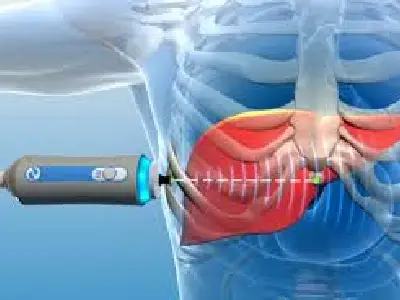Fibroscan

A FibroScan is a medical device used to assess the degree of liver fibrosis and fat accumulation in the liver non-invasively. Liver fibrosis is the scarring of liver tissue, often caused by conditions like hepatitis, fatty liver disease, or excessive alcohol consumption. Assessing the extent of fibrosis is crucial in managing liver disease, as it helps determine the level of liver damage and guides treatment decisions.
Here’s how a FibroScan works and what you should know about it:
Principle of Operation: The FibroScan uses a technology called transient elastography. It involves sending a mild vibration or ultrasound wave through the liver tissue and measuring how quickly it travels through the tissue. The speed of the wave is directly related to the stiffness or elasticity of the liver. A stiffer liver is indicative of more fibrosis or scarring.
Procedure: During a FibroScan procedure, the patient typically lies on their back, and a trained healthcare provider places the FibroScan probe on the skin overlying the liver. A small amount of gel is applied to the skin to improve contact between the probe and the skin. The probe then emits a pulse, and the device measures the liver’s stiffness at multiple points.
Results: The results are usually expressed in kilopascals (kPa), with higher values indicating greater liver stiffness and potentially more advanced fibrosis. The device may also provide a liver fat measurement in a similar manner, which is helpful in cases of non-alcoholic fatty liver disease (NAFLD).
Interpretation: The FibroScan results are used by healthcare providers to assess the extent of liver fibrosis and fat accumulation. Depending on the specific machine and the scoring system used, results may be categorized into different stages of fibrosis, such as F0 (no fibrosis) to F4 (cirrhosis). The results guide treatment decisions, such as whether to initiate antiviral therapy for hepatitis or make lifestyle changes for fatty liver disease.
Benefits of FibroScan:
- Non-invasive: Unlike a liver biopsy, which is an invasive procedure, FibroScan is a non-invasive and painless way to assess liver fibrosis.
- Quick: The procedure is typically fast and can often be performed during a routine clinic visit.
- Repeated Testing: Because it’s non-invasive, FibroScan can be performed at various time points to monitor the progression or regression of liver fibrosis.
Limitations of FibroScan:
- Operator-Dependent: The quality of FibroScan results can be influenced by operator technique, so it’s important to have trained professionals perform the procedure.
- Limited to Liver: FibroScan is specific to the liver and cannot provide information about other organs or conditions.
FibroScan is a valuable tool in the management of liver diseases, allowing for the timely assessment of liver fibrosis and fat content without the need for invasive procedures. However, its results should be interpreted in conjunction with other clinical and laboratory data to provide a comprehensive assessment of a patient’s liver health.
